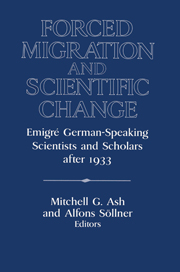Book contents
- Frontmatter
- Introduction: Forced Migration and Scientific Change after 1933
- PART ONE PHYSICAL AND MEDICAL SCIENCES
- PART TWO PSYCHOLOGY, PSYCHONALYSIS, PEDAGOGY
- 5 Emigré Psychologists after 1933: The Cultural Coding of Scientific and Professional Practices
- 6 Psychoanalytic Science: From Oedipus to Culture
- 7 The Impact of Emigration on German Pedagogy
- PART THREE SOCIAL SCIENCES
- Epilogue: The Refugee Scholar in America: The Case of Paul Tillich
- Index
6 - Psychoanalytic Science: From Oedipus to Culture
Published online by Cambridge University Press: 05 January 2013
- Frontmatter
- Introduction: Forced Migration and Scientific Change after 1933
- PART ONE PHYSICAL AND MEDICAL SCIENCES
- PART TWO PSYCHOLOGY, PSYCHONALYSIS, PEDAGOGY
- 5 Emigré Psychologists after 1933: The Cultural Coding of Scientific and Professional Practices
- 6 Psychoanalytic Science: From Oedipus to Culture
- 7 The Impact of Emigration on German Pedagogy
- PART THREE SOCIAL SCIENCES
- Epilogue: The Refugee Scholar in America: The Case of Paul Tillich
- Index
Summary
In 1944, in “Psychoanalysis and Sociology,” Heinz Hartmann, who would be the leading psychoanalyst for years to come, stated that many problems belonging to the social sciences must be examined with the help of psychoanalysis. By 1950, he argued for the creation of a common conceptual language for the social sciences, in order to define sociological problems in terms of their psychological meaning and, vice versa, to formulate psychological ones in direct relation to the social structure. The following year, at a meeting of the Psychoanalytic Section of the American Psychiatric Association, Talcott Parsons, the leading American sociologist, stated that the influence of psychoanalysis had “deepened and enriched the understanding of human motivation and had become pervasive in the social sciences.”
Only fifteen years before, Rudolph Loewenstein, who would become Hartmann's co-author of the most central concepts in so-called American ego psychology, which would come to dominate psychoanalysis worldwide, had taken what we would consider the most standard “biological” approach, which he had based squarely on the Oedipus complex. How did Loewenstein get from his classification of the four phases in the development of male sexuality that “normally constitute the genital automatism” - desire, erection, ejaculation, orgasm - to his “pertinent propositions for interdisciplinary cooperation?” How come that already by 1949 he was accepting and defining “instinctual drive not [as] identical with the one used in animal psychology, but [as] a construct particularly designed to describe the phenomena of conflict in man which psychoanalysis studies? Simply put, what had led him to broaden the notion of “biology?”
- Type
- Chapter
- Information
- Forced Migration and Scientific ChangeEmigré German-Speaking Scientists and Scholars after 1933, pp. 139 - 155Publisher: Cambridge University PressPrint publication year: 1996
- 4
- Cited by



